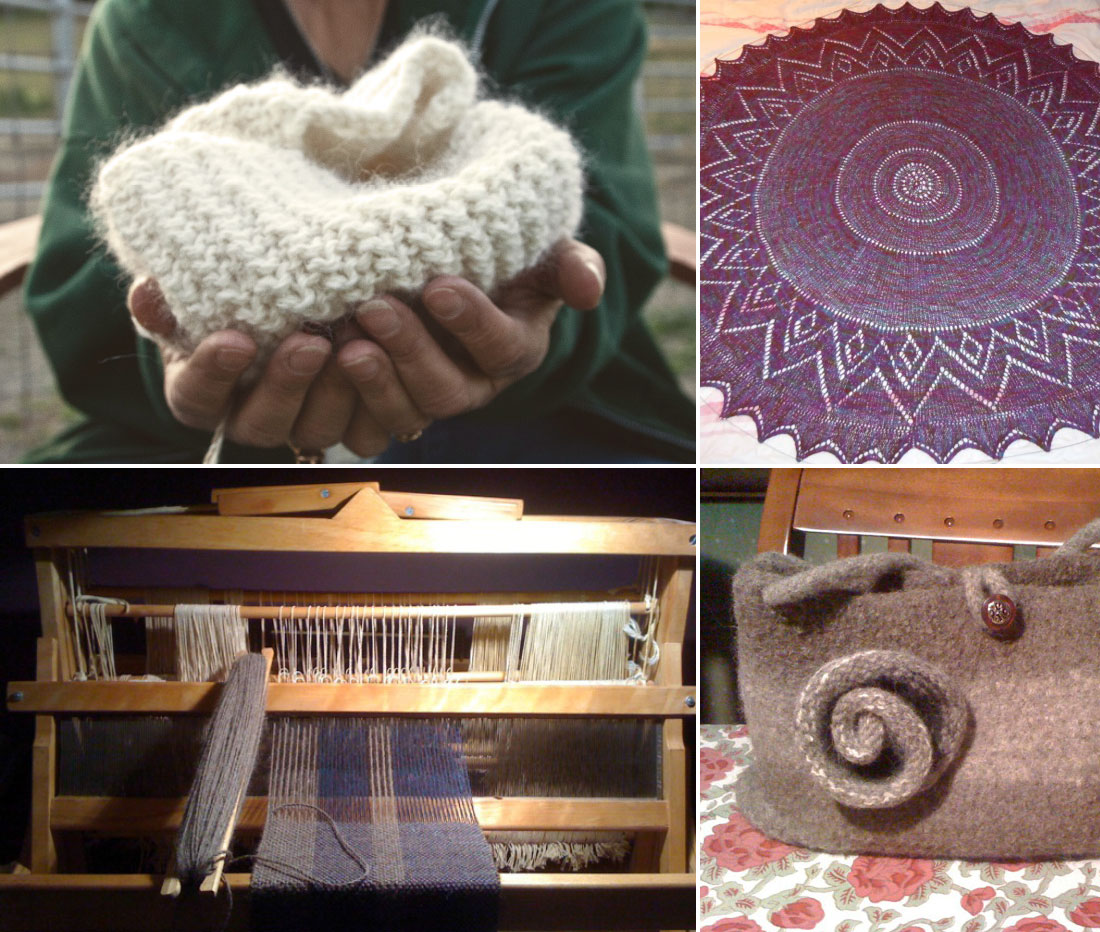
For anyone who has felt the incredible softness of alpaca fiber, it’s easy to understand why an avid knitter like Debbie Emery was instantly attracted to these peaceful camelids. She describes alpacas as “so gentle, and almost zen-like.” And points out that they are also very eco-friendly due to their soft, hoof-less feet. “But it’s the fiber that I really enjoy the most,” she states emphatically.
Debbie started knitting in earnest around 2000 (despite an unsuccessful attempt to learn when she was in her 20s), influenced by her grown daughter Sarah, who was thoroughly into spinning, knitting and sewing at the time, and provided encouragement. Debbie spins and weaves as well, but knitting is her favorite. A few years later, when her husband Mark retired from his job as Glen Ellen Fire District’s Assistant Chief and Debbie retired from working as a Human Resources Director (first in the wine industry and then at a local community bank), they decided to raise fiber animals on Mark’s family property, where they have now lived for 39 years.

Debbie is no stranger to farm life, having grown up on a 6-acre farm in Sonoma County with her parents and seven siblings. The family had a huge garden, laying hens, a milk cow, a steer, pigs, and a variety of other animals. And the Emerys have raised many different animals over the years, some with their two daughters for 4-H, and some for their own use and enjoyment. “Nubian dairy goats were probably the most involved project of our animals,” recalls Debbie. “We raised them mainly for the milk, for our family, and for some friends. We raised them for about 15 years, but stopped when I went back to working full-time.” Then, when Debbie and Mark retired, the time was right for them to start their fiber farm as a way to invest in and improve the land, and “Brookfarm, Alpacas in the Valley of the Moon” was born.
There’s a lot to love about alpacas, domesticated by the Incas more than 6,000 years ago and raised for their exquisite fleece. Alpaca fiber is much like sheep’s wool, but warmer, softer, and not itchy. It is lacking in lanolin, which makes it hypoallergenic and also allows it to be processed without the need for high temperatures in washing.

There’s a large alpaca farming community these days, which Debbie says has been very supportive with lots of sharing and camaraderie. The Emerys know pretty much everyone in the area who is raising alpacas. Currently Debbie and Mark have 30 alpacas on their farm; 12 are theirs and the others are animals that they board. The fiber ranges from an amazing 14 microns on one of their premier, Color Champion ribbon winners (she’s offspring to their herdsire, Rocky, also a color champion with very consistent 21 micron fiber), to high 20s on the older breeding animals.
Debbie has the fiber processed at Ranch of the Oaks in Lompoc, where Mette and Tom are alpaca owners themselves and experienced with alpaca fiber. According to Debbie they do a great job, and so she is able to provide beautiful yarn and roving, in addition to raw fiber, in several of the 22 natural colors of alpaca fleece that are recognized by the textile industry. You can buy Brookfarm Alpaca products on their website (www.brookfarmalpaca.com) as well as by coming to the farm to shop by appointment. Debbie and Mark even offer a fiber CSA for those who want first choice of current offerings.

But not all their fiber leaves the farm, due to Debbie’s passion for knitting, which is apparent as she talks about it. “I’ve knit all sorts of things. I started with scarf after scarf, and then moved on to hats and socks. Eventually I felt brave enough to make shawls, vests, and sweaters, amongst other things. Two of my favorites are a felted cabled iPad case, and a felted purse that won Best of Show at the Sonoma County Fair a few years back. I’ve created a couple of patterns, but just for myself. Most of my inspiration comes from the large group of knitting/spinning friends I get together with regularly, from Ravelry and online searches, and from my small library of books. Since two grandsons entered my life almost three years ago, I’ve had a ball making infant sweaters and hats.”

The alpacas at Brookfarm seem very content in such a beautiful setting, with pasture to roam as well as shelter. They were quietly munching their breakfast on the day I visited, so unfortunately I didn’t get a chance to hear them hum. Alpacas hum to find each other, and to communicate with the herd. Each mom and baby hums to the other as part of the bonding process, and each has its distinct hum, just as people all have distinct voices.
Another unusual thing about alpacas that I learned from Debbie is that they have community manure piles, and go only in those spots. This makes it easy to collect and compost the manure beans. Alpaca manure is highly sought for gardening since it is completely digested and not hot, so it can be used to top-dress garden beds without harming the plants. Every fall Debbie and Mark distribute their herd’s composted alpaca beans over part of the pasture, and seed it with forage. This yields a few months of fresh grass to supplement the dry forage of orchard grass that the alpacas normally eat.
Life at Brookfarm is good, and as Debbie describes it, “We have a full and happy life with the alpacas, our family, and getting out camping now and again.” But for a fiber lover like Debbie, there’s always the temptation to bring other fiber animals into the fold. We’ll see what happens when she attends Black Sheep Gathering this week.

Photos by Alycia Lang, except where noted.
